Analyzing the Seasonal Variability in South China Sea Surface Currents with Drifter Observations, Satellite-Derived Data, and Reanalysis Data
Abstract
1. Introduction
2. Data and Methods
2.1. Data
2.2. Methods
- First, the daily average speed values along the drifter trajectories were calculated; subsequently, the average speeds for the first, middle, and last deciles (ten-day periods) of the month were derived from these daily values.
- Given that the overall speed values from CMEMS are generally lower than those recorded by the drifters, an alternative approach was adopted for processing the CMEMS data. Specifically, for each day along the drifter trajectory, the maximum CMEMS speed value corresponding to that day was selected as the daily representative value. Based on these daily maxima, the average speeds for the first, middle, and last deciles of the month were subsequently calculated.
- The results obtained from (1) and (2) were compared, as presented in Table 2 and Table 3.
- Averaging of winter CMEMS current fields: For each year, the CMEMS-reanalyzed current field was averaged over the months of January and February to represent the winter flow field.
- Selection of consistent trajectories: Trajectory segments from the drifter data were selected based on consistency between drifter-derived speeds and CMEMS current speeds, following the methodology outlined above.
- Extraction of daily representative speeds: For each consistent segment, CMEMS current speeds at the corresponding drifter positions were extracted. The maximum value within each segment was then selected as the representative daily speed, in accordance with the previously described method.
- Computation of annual winter speed: The representative speeds obtained in step (3) were averaged to yield the annual mean winter current speed for each year.
3. Results
3.1. General Characteristics of the Seasonal Surface Current in the SCS
3.2. Characteristics of the SCS Surface Current in Spring
3.3. Characteristics of the SCS Surface Current in Summer
| Drifter ID | Period | Longitude (° E) | Latitude (° N) | Average Speed of Drifter (m/s) | Average Flow Speed from CMEMS (m/s) | Speed Deviation (m/s) |
|---|---|---|---|---|---|---|
| 1485509 | 11–20 June 2021 | 118.1399 | 19.9279 | 0.27 [0.185, 0.351] | 0.27 [0.195, 0.352] | 0.00 |
| 1485509 | 21–30 June 2021 | 120.2110 | 20.2524 | 0.31 [0.232, 0.394] | 0.37 [0.315, 0.433] | −0.06 |
| 1485512 | 21–31 July 2021 | 118.6118 | 23.3866 | 0.25 [0.138, 0.369] | 0.22 [0.118, 0.330] | 0.03 |
| 1485514 | 11–20 June 2021 | 113.1734 | 17.2482 | 0.24 [0.099, 0.415] | 0.29 [0.173, 0.431] | −0.05 |
| 1485514 | 21–30 June 2021 | 114.9728 | 16.5165 | 0.18 [0.112, 0.271] | 0.21 [0.158, 0.276] | −0.03 |
| 1485515 | 1–10 June 2021 | 114.5469 | 16.4492 | 0.18 [0.094, 0.275] | 0.20 [0.115, 0.292] | −0.02 |
| 1485515 | 21–30 June 2021 | 116.2330 | 15.9961 | 0.23 [0.185, 0.272] | 0.20 [0.167, 0.237] | 0.03 |
| 1485580 | 1–10 June 2021 | 116.4293 | 17.3641 | 0.23 [0.144, 0.346] | 0.21 [0.121, 0.316] | 0.02 |
| 1485580 | 11–20 June 2021 | 117.7803 | 19.1448 | 0.27 [0.203, 0.348] | 0.28 [0.206, 0.360] | −0.01 |
| 1485585 | 21–31 July 2021 | 114.7614 | 20.8658 | 0.20 [0.106, 0.307] | 0.24 [0.219, 0.271] | −0.04 |
| 1485585 | 1–10 August 2021 | 117.8334 | 22.1463 | 0.59 [0.361, 0.860] | 0.53 [0.347, 0.728] | 0.06 |
| 1485615 | 11–20 July 2021 | 118.1686 | 19.0234 | 0.08 [0.039, 0.149] | 0.08 [0.042, 0.126] | 0.00 |
| 1485615 | 21–31 July 2021 | 119.6485 | 19.8371 | 0.27 [0.199, 0.341] | 0.22 [0.169, 0.266] | 0.05 |
| 1485622 | 11–20 July 2021 | 118.5241 | 22.1147 | 0.30 [0.212, 0.417] | 0.35 [0.269, 0.428] | −0.05 |
| 1490030 | 21–31 July 2021 | 117.4186 | 19.6545 | 0.20 [0.145, 0.262] | 0.14 [0.056, 0.253] | 0.06 |
3.4. Characteristics of the SCS Surface Current in Autumn
3.5. Characteristics of the SCS Surface Current in Winter
| Drifter ID | Period | Longitude (° E) | Latitude (° N) | Average Speed of Drifter (m/s) | Average Flow Speed from CMEMS (m/s) | Speed Deviation (m/s) |
|---|---|---|---|---|---|---|
| 1485506 | 11–20 January 2021 | 114.8010 | 18.3092 | 0.35 [0.293, 0.408] | 0.38 [0.344, 0.419] | −0.03 |
| 1485506 | 21–31 January 2021 | 111.7719 | 17.3382 | 0.33 [0.280, 0.372] | 0.38 [0.347, 0.414] | −0.05 |
| 1485506 | 1–10 February 2021 | 109.7851 | 16.6480 | 0.22 [0.137, 0.321] | 0.25 [0.181, 0.321] | −0.03 |
| 1485506 | 11–20 February 2021 | 109.5776 | 12.8640 | 0.74 [0.637, 0.852] | 0.70 [0.624, 0.777] | 0.04 |
| 1485518 | 11–20 January 2021 | 116.7646 | 19.1972 | 0.43 [0.362, 0.493] | 0.36 [0.259, 0.486] | 0.07 |
| 1485518 | 21–31 January 2021 | 114.3990 | 17.7808 | 0.31 [0.262, 0.364] | 0.40 [0.333, 0.466] | −0.09 |
| 1485518 | 1–10 February 2021 | 111.6861 | 17.1915 | 0.30 [0.244, 0.358] | 0.25 [0.200, 0.308] | 0.05 |
| 1485518 | 11–20 February 2021 | 109.5197 | 15.7499 | 0.39 [0.257, 0.541] | 0.34 [0.217, 0.479] | 0.05 |
| 1485505 | 11–20 February 2021 | 115.1941 | 20.1998 | 0.41 [0.332, 0.492] | 0.38 [0.339, 0.413] | 0.03 |
| 1485508 | 1–10 January 2021 | 117.4147 | 20.0188 | 0.51 [0.389, 0.646] | 0.49 [0.376, 0.598] | 0.02 |
| 1485508 | 11–20 January 2021 | 114.7672 | 18.3595 | 0.34 [0.276, 0.409] | 0.37 [0.343, 0.406] | −0.03 |
4. Discussion
4.1. Interannual Variation in the SCS Surface Current in Winter
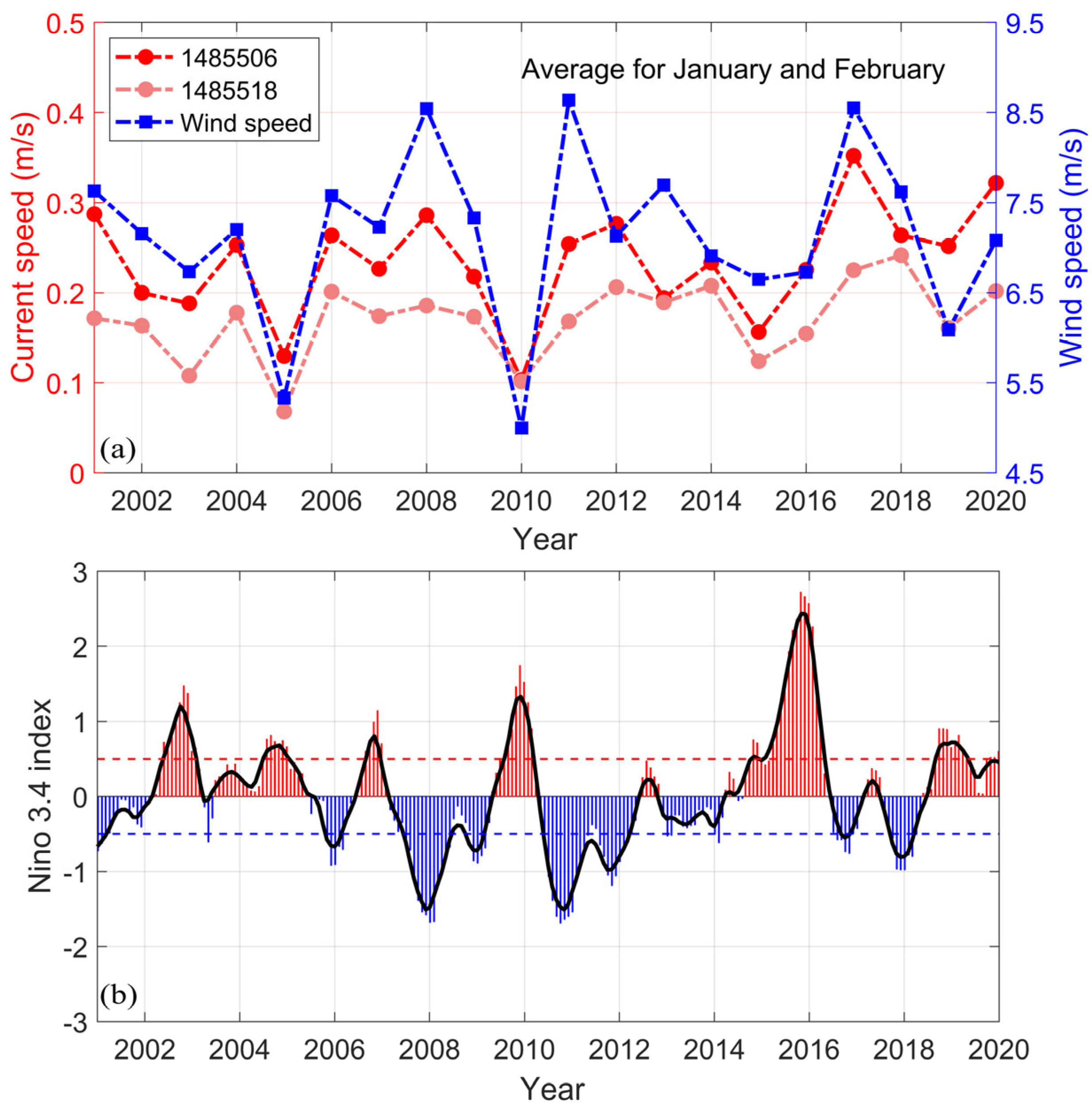
4.2. Patterns of the SCSWBC in Winter and Summer
5. Conclusions
Author Contributions
Funding
Data Availability Statement
Acknowledgments
Conflicts of Interest
References
- Hu, J.Y.; Kawamura, H.; Hong, H.S.; Qi, Y.Q. A review on the currents in the South China Sea: Seasonal circulation, South China Sea warm current and Kuroshio intrusion. J. Oceanogr. 2000, 56, 607–624. [Google Scholar] [CrossRef]
- Zhu, Y.H.; Sun, J.C.; Wang, Y.G.; Li, S.J. Overview of the multi-layer circulation in the South China Sea. Prog. Oceanogr. 2019, 175, 171–182. [Google Scholar] [CrossRef]
- Guo, J.J.; Fang, W.D.; Fang, G.H.; Chen, H.Y. Variability of surface circulation in the South China Sea from satellite altimeter data. Sci. Bull. 2006, 51, 1–8. [Google Scholar] [CrossRef]
- Wyrki, K. Physical Oceanography of the Southeast Asian Waters, 1st ed.; University of California, Scripps Institution of Oceanography Press: California, CA, USA, 1961; pp. 1–195. [Google Scholar]
- Xu, X.; Qiu, Z.; Chen, H. The general description of the horizontal circulation in the South China Sea. In Proceedings of the 1980 Symposium on Hydrometeorology; Chinese Society of Oceanology and Limnology, Ed.; Science Press: Beijing, China, 1982; Volume 3, pp. 137–145. (In Chinese). [Google Scholar]
- Shaw, P.T.; Chao, S.Y. Surface circulation in South China Sea. Deep Sea Res. Part I 1994, 41, 1663–1683. [Google Scholar] [CrossRef]
- Chu, P.C.; Edmons, N.L.; Fan, C.W. Dynamical mechanisms for the South China Sea seasonal circulation and thermohaline variabilities. J. Phys. Oceanogr. 1999, 29, 2971–2989. [Google Scholar] [CrossRef]
- Chern, C.S.; Wang, J. Numerical study of the upper-layer circulation in the South China Sea. J. Oceanogr. 2003, 59, 11–24. [Google Scholar] [CrossRef]
- Gan, J.P.; Li, H.; Curchitser, E.N.; Haidvogel, D.B. Modeling South China Sea circulation: Response to seasonal forcing regimes. J. Geophys. Res. Oceans 2006, 111, C06034. [Google Scholar] [CrossRef]
- Fang, G.H.; Wang, Y.G.; Wei, Z.X.; Fang, Y.; Qiao, F.L.; Hu, X.M. Interocean circulation and heat and freshwater budgets of the South China Sea based on a numerical model. Dynam. Atmos. Oceans 2009, 47, 55–72. [Google Scholar] [CrossRef]
- Tangang, F.T.; Xia, C.S.; Qiao, F.L.; Juneng, L.; Shan, F.Z. Seasonal circulations in the Malay Peninsula eastern continental shelf from a wave-tide-circulation coupled model. Ocean Dyn. 2011, 61, 1317–1328. [Google Scholar] [CrossRef]
- Wei, Z.X.; Fang, G.H.; Xu, T.F.; Wang, Y.G.; Lian, Z. Seasonal variability of the isopycnal surface circulation in the South China Sea derived from a variable-grid global ocean circulation model. Acta Oceanol. Sin. 2016, 35, 11–20. [Google Scholar] [CrossRef]
- Shaw, P.T.; Chao, S.Y.; Fu, L.L. Sea surface height variations in the South China Sea from satellite altimetry. Oceanol. Acta 1999, 22, 1–17. [Google Scholar] [CrossRef]
- Ho, C.R.; Kuo, N.J.; Zheng, Q.A.; Soong, Y.S. Dynamically active areas in the South China Sea detected from TOPEX/POSEIDON satellite altimeter data. Remote. Sens. Environ. 2000, 71, 320–328. [Google Scholar] [CrossRef]
- Wang, L.P.; Koblinsky, C.J.; Howden, S. Mesoscale variability in the South China Sea from the TOPEX/Poseidon altimetry data. Deep Sea Res. Part I 2000, 47, 681–708. [Google Scholar] [CrossRef]
- Xie, S.P.; Xie, Q.; Wang, D.X.; Liu, W.T. Summer upwelling in the South China Sea and its role in regional climate variations. J. Geophys. Res. Oceans 2003, 108, 3261. [Google Scholar] [CrossRef]
- Bao, L.F.; Lu, Y.; Wang, Y.; Xsu, H.Z. Seasonal variation of upper ocean circulation over the South China Sea from satellite altimetry data of many years. Chin. J. Geophys. 2005, 48, 543–550. [Google Scholar] [CrossRef]
- Rong, Z.R.; Liu, Y.G.; Zong, H.B.; Cheng, Y.C. Interannual sea level variability in the South China Sea and its response to ENSO. Global Planet. Change 2007, 55, 257–272. [Google Scholar] [CrossRef]
- Cai, S.Q.; He, Y.H. Association of the Sulu Sea surface circulation with the South China Sea. J. Mar. Syst. 2010, 81, 335–340. [Google Scholar] [CrossRef]
- Benny, N.P.; Mridula, K.R.; Razali, M.M.; Ses, S.; Omar, K.M. Northern South China Sea surface circulation and its variability derived by combining satellite altimetry and surface drifter data. Terr. Atmos. Ocean. Sci. 2015, 26, 193–203. [Google Scholar] [CrossRef][Green Version]
- Liu, J.; Dai, J.J.; Xu, D.F.; Wang, J.; Yuan, Y.P. Seasonal and interannual variability in coastal circulations in the northern South China sea. Water 2018, 10, 520. [Google Scholar] [CrossRef]
- Fu, Y.G.; Zhou, X.H.; Zhou, D.X.; Li, J.; Zhang, W.J. Estimation of sea level variability in the South China Sea from satellite altimetry and tide gauge data. Adv. Space Res. 2021, 68, 523–533. [Google Scholar] [CrossRef]
- Zhong, Y.S.; Zhou, M.; Waniek, J.J.; Zhou, L.; Zhang, Z.R. Seasonal variation of the surface Kuroshio intrusion into the South China Sea evidenced by satellite geostrophic streamlines. J. Phys. Oceanogr. 2021, 51, 2705–2718. [Google Scholar] [CrossRef]
- Su, J.Z.; Lu, J.; Hou, Y.J.; Fang, G.H.; Wei, Z.X.; Yin, B.S. Analysis of satellite-tracked drifting buoys in the South China Sea. Oceanol. Limnol. Sin. 2002, 33, 121–127. [Google Scholar]
- He, Z.G.; Wang, D.X. Surface pattern of the South China Sea western boundary current in winter. Adv. Geosci. 2009, 12, 99–107. [Google Scholar] [CrossRef]
- Centurioni, L.R.; Niiler, P.N.; Lee, D.K. Near-surface circulation in the South China Sea during the winter monsoon. Geophys. Res. Lett. 2009, 36, L06605. [Google Scholar] [CrossRef]
- Qiu, Y.; Li, L.; Chen, C.T.A.; Guo, X.; Jing, C. Currents in the Taiwan Strait as observed by surface drifters. J. Oceanogr. 2011, 67, 395–404. [Google Scholar] [CrossRef]
- Liu, K.F.; Jiang, G.R.; Chen, Y.D.; Yao, J.; Sheng, C. Analysis of upper-ocean surface currents of the South China Sea derived from satellite-tracked drifter data. J. Trop. Oceanogr. 2014, 33, 13–21. [Google Scholar] [CrossRef]
- Hsu, P.C.; Centurioni, L.; Shao, H.J.; Zheng, Q.A.; Lu, C.Y.; Hsu, T.W.; Tseng, R.S. Surface current variations and oceanic fronts in the southern East China Sea: Drifter experiments, coastal radar applications, and satellite observations. J. Geophys. Res. Oceans 2021, 126, e2021JC017373. [Google Scholar] [CrossRef]
- Hu, Z.Y.; Yang, L.Q.; Chen, Z.Z.; Zhu, J.; Sun, Z.Y.; Hu, J.Y. Drifter-observed reversal of the South China Sea Western Boundary Current from summer to autumn. Mar. Technol. Soc. J. 2023, 57, 34–46. [Google Scholar] [CrossRef]
- Tuo, P.F.; Hu, Z.Y.; Chen, S.L.; Hu, J.Y.; Yu, P.N. Asymmetric drifter trajectories in an anticyclonic mesoscale eddy. Remote Sens. 2023, 15, 3806. [Google Scholar] [CrossRef]
- Gu, J.T.; Zhang, Y.; Tuo, P.F.; Hu, Z.Y.; Chen, S.L.; Hu, J.Y. Surface floating objects moving from the Pearl River Estuary to Hainan Island: An observational and model study. J. Mar. Syst. 2024, 241, 103917. [Google Scholar] [CrossRef]
- Gu, J.T.; Zhang, Y.; Sui, Y.; Chen, S.L. Lagrangian study of floating debris transport around the Pearl River Estuary in summer. Mar. Pollut. Bull. 2025, 211, 117494. [Google Scholar] [CrossRef]
- Li, J.Y.; Li, M.; Xian, Z.Y.; Xie, L.L. Satellite tracked Lagrangian drifters observed Yuexi cyclonic eddy. Acta Oceanol. Sin. 2025, 44, 150–152. [Google Scholar] [CrossRef]
- Niiler, P.P.; Sybrandy, A.S.; Bi, K.; Poulain, P.M.; Bitterman, D. Measurements of the water-following capability of holey-sock and TRISTAR drifters. Deep Sea Res. Part I 1995, 42, 1951–1964. [Google Scholar] [CrossRef]
- Sun, Z.Y.; Hu, J.Y.; Lin, H.Y.; Chen, Z.Z.; Zhu, J.; Yang, L.Q.; Hu, Z.Y.; Chen, X.R.; Wu, X.W. Lagrangian observation of the Kuroshio current by surface drifters in 2019. J. Mar. Sci. Eng. 2022, 10, 1027. [Google Scholar] [CrossRef]
- Sun, Z.Y.; Hu, J.Y.; Chen, Z.Z.; Zhu, J.; Yang, L.Q.; Chen, X.R.; Wu, X.W. Strong Kuroshio intrusion into the South China Sea and its accompanying cold-core anticyclonic eddy in winter 2020–2021. Remote Sens. 2021, 13, 2645. [Google Scholar] [CrossRef]
- Hansen, D.V.; Poulain, P.M. Quality control and interpolations of WOCE-TOGA drifter data. J. Atmos. Ocean. Technol. 1996, 13, 900–909. [Google Scholar] [CrossRef]
- Mason, E.; Pascual, A.; Gaube, P.; Ruiz, S.; Pelegrí, J.L.; Delepoulle, A. Subregional characterization of mesoscale eddies across the Brazil–Malvinas Confluence. J. Geophys. Res. Oceans 2017, 122, 3329–3357. [Google Scholar] [CrossRef]
- Mason, E.; Pascual, A.P.; McWilliams, J.C. A new sea surface height–based code for oceanic mesoscale eddy tracking. J. Atmos. Ocean. Technol. 2014, 31, 1181–1188. [Google Scholar] [CrossRef]
- Pegliasco, C.; Delepoulle, A.; Mason, E.; Morrow, R.; Faugère, Y.; Dibarboure, G. META3.1exp: A new Global Mesoscale Eddy Trajectories Atlas derived from altimetry. Earth Syst. Sci. Data 2022, 14, 1087–1107. [Google Scholar] [CrossRef]
- Qiu, C.H.; Yang, Z.H.; Wang, D.X.; Feng, M.; Su, J.Z. The enhancement of submesoscale ageostrophic motion on the mesoscale eddies in the South China Sea. J. Geophys. Res. Oceans 2022, 127, e2022JC018736. [Google Scholar] [CrossRef]
- Li, L.; Nowlin, W.D.; Su, J.L. Anticyclonic rings from the Kuroshio in the South China Sea. Deep Sea Res. Part I 1998, 45, 1469–1482. [Google Scholar] [CrossRef]
- Jia, Y.L.; Liu, Q.Y.; Liu, W. Eddy shedding from the Kuroshio bend at Luzon Strait. J. Oceanogr. 2004, 60, 1063–1069. [Google Scholar] [CrossRef]
- Yuan, D.L.; Han, W.Q.; Hu, D.X. Surface Kuroshio path in the Luzon Strait area derived from satellite remote sensing data. J. Geophys. Res. Oceans 2006, 111, C11007. [Google Scholar] [CrossRef]
- Zhang, Z.W.; Zhao, W.; Qiu, B.; Tian, J.W. Anticyclonic eddy sheddings from Kuroshio loop and the accompanying cyclonic eddy in the northeastern South China Sea. J. Phys. Oceanogr. 2017, 47, 1243–1259. [Google Scholar] [CrossRef]
- Wang, D.X.; Xu, H.Z.; Lin, J.; Hu, J.Y. Anticyclonic eddies in the northeastern South China Sea during winter 2003/2004. J. Oceanogr. 2008, 64, 925–935. [Google Scholar] [CrossRef]
- Capet, X.; McWilliams, J.C.; Molemaker, M.J.; Shchepetkin, A.F. Mesoscale to submesoscale transition in the California current system. Part II: Frontal processes. J. Phys. Oceanogr. 2008, 38, 44–64. [Google Scholar] [CrossRef]
- Zhang, Z.G.; Qiu, B. Evolution of submesoscale ageostrophic motions through the life cycle of oceanic mesoscale eddies. Geophys. Res. Lett. 2018, 45, 11847–11855. [Google Scholar] [CrossRef]
- McWilliams, J.C. Submesoscale currents in the ocean. Proc. R. Soc. A Math. Phys. 2016, 472, 20160117. [Google Scholar] [CrossRef]
- Jan, S.; Mensah, V.; Andres, M.; Chang, M.H.; Yang, Y.J. Eddy-Kuroshio interactions: Local and remote effects. J. Geophys. Res. Oceans 2017, 122, 9744–9764. [Google Scholar] [CrossRef]
- Xu, C.; Zhai, X.M.; Shang, X.D. Work done by atmospheric winds on mesoscale ocean eddies. Geophys. Res. Lett. 2016, 43, 12174–12180. [Google Scholar] [CrossRef]
- Rypina, I.I.; Fertitta, D.; Macdonald, A.; Yoshida, S.; Jayne, S. Multi-iteration approach to studying tracer spreading using drifter data. J. Phys. Oceanogr. 2017, 47, 339–351. [Google Scholar] [CrossRef]
- Chen, G.X.; Xue, H.J. Westward intensification in marginal seas. Ocean Dyn. 2014, 64, 337–345. [Google Scholar] [CrossRef]
- Quan, Q.; Xue, H.J.; Qin, H.L.; Zeng, X.Z.; Peng, S.Q. Features and variability of the South China Sea western boundary current from 1992 to 2011. Ocean Dyn. 2016, 66, 795–810. [Google Scholar] [CrossRef]
- Gan, J.P.; Qu, T.D. Coastal jet separation and associated flow variability in the southwest South China Sea. Deep Sea Res. Part I 2008, 55, 1–19. [Google Scholar] [CrossRef]
- Wang, G.H.; Wang, C.Z.; Huang, R.X. Interdecadal variability of the eastward current in the South China Sea associated with the summer Asian monsoon. J. Clim. 2010, 23, 6115–6123. [Google Scholar] [CrossRef]
- Zu, T.T.; Wang, D.X.; Wang, Q.; Li, M.T.; Wei, J.; Geng, B.X.; He, Y.K.; Chen, J. A revisit of the interannual variation of the South China Sea upper layer circulation in summer: Correlation between the eastward jet and northward branch. Clim. Dyn. 2020, 54, 457–471. [Google Scholar] [CrossRef]
- Yan, Y.W.; Wang, G.H.; Xue, H.J.; Chai, F. Buoyancy effect on the winter South China Sea western boundary current. J. Geophys. Res. Oceans 2019, 124, 6871–6885. [Google Scholar] [CrossRef]




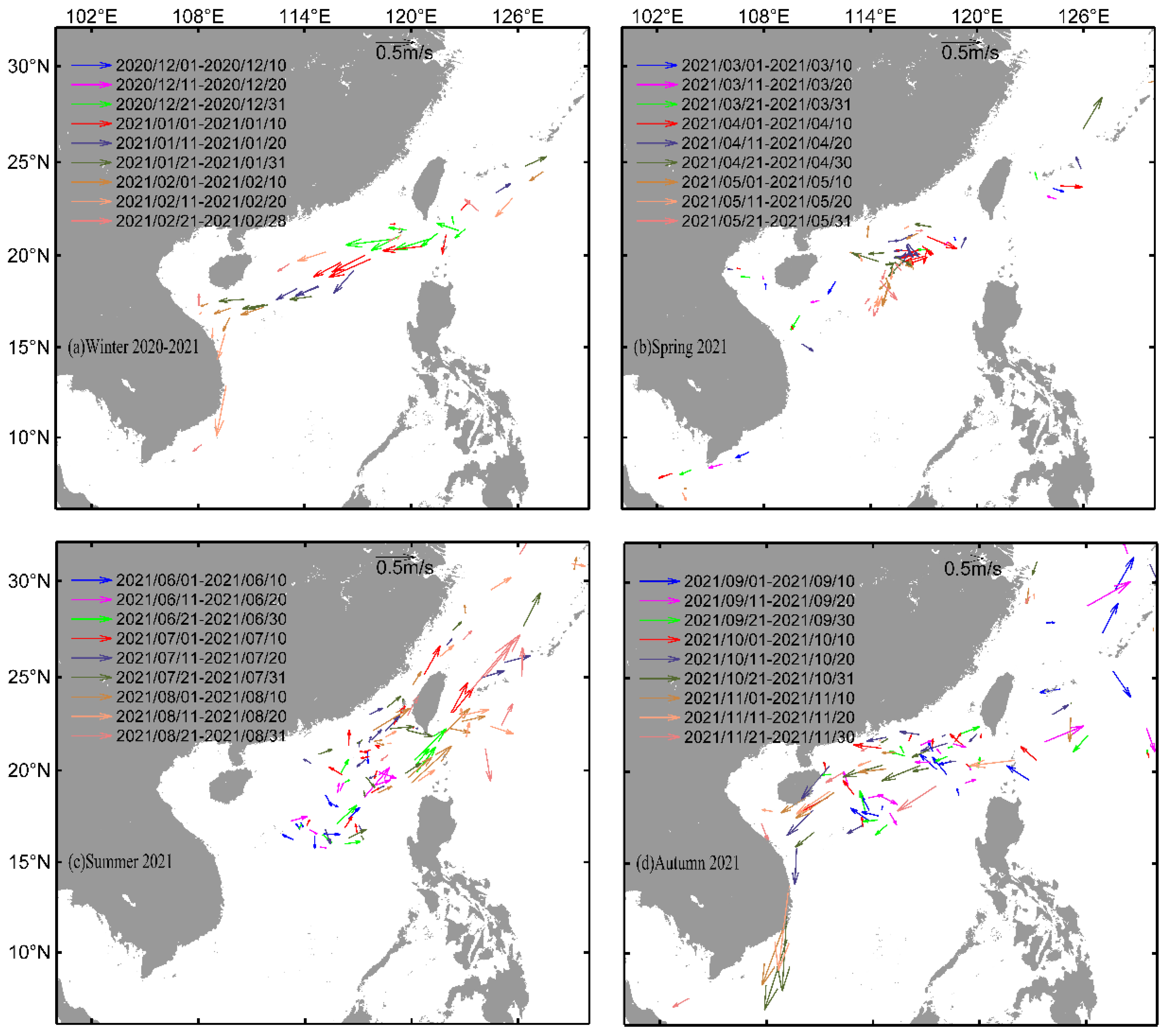
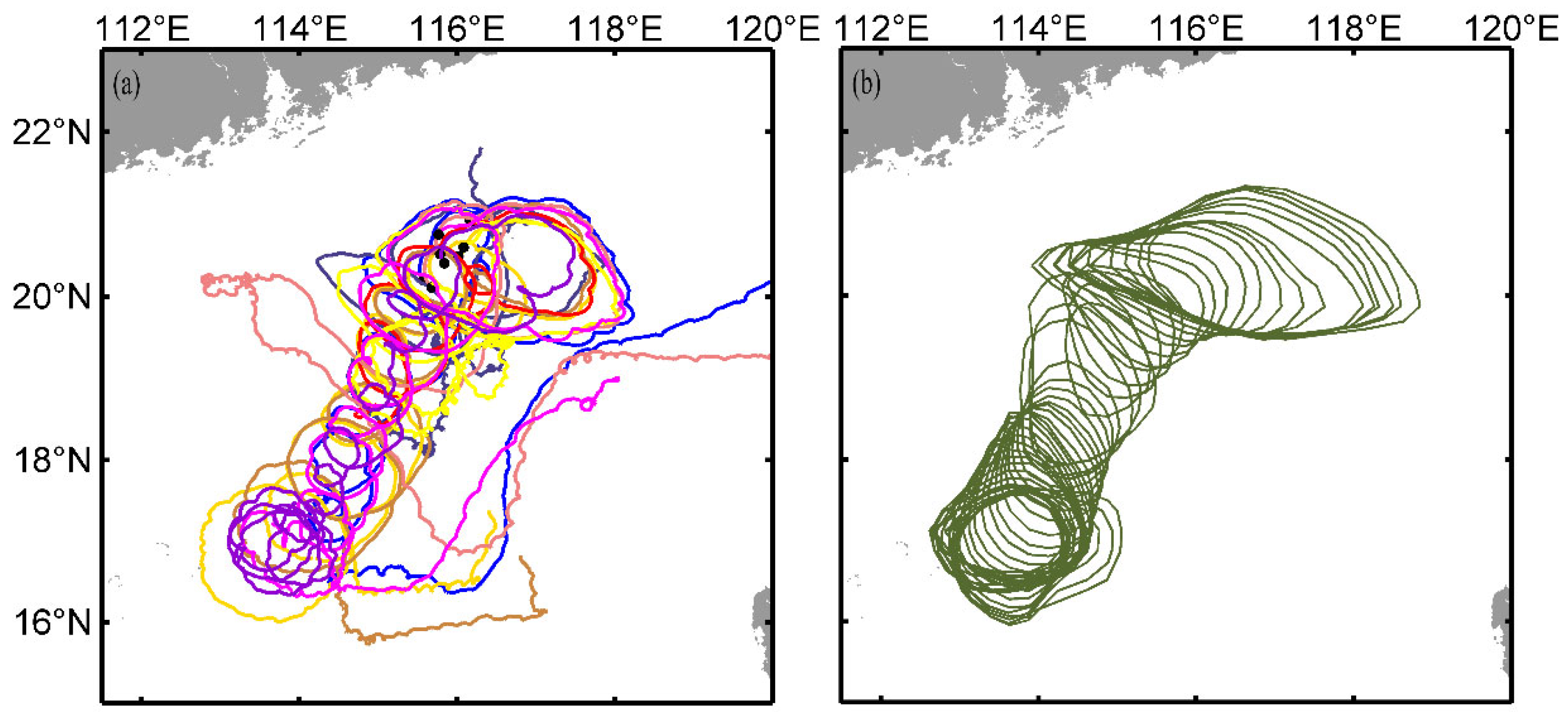
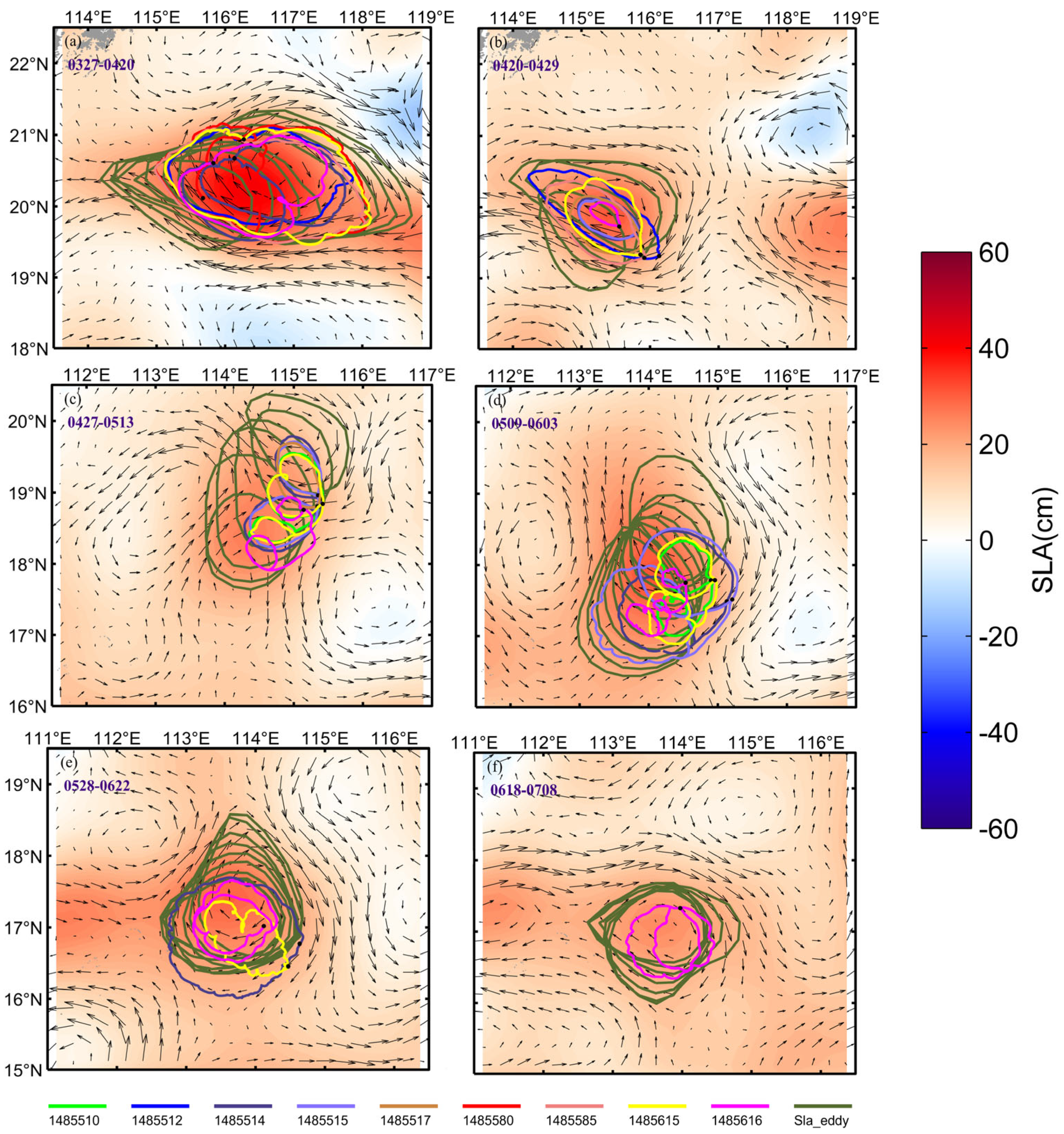
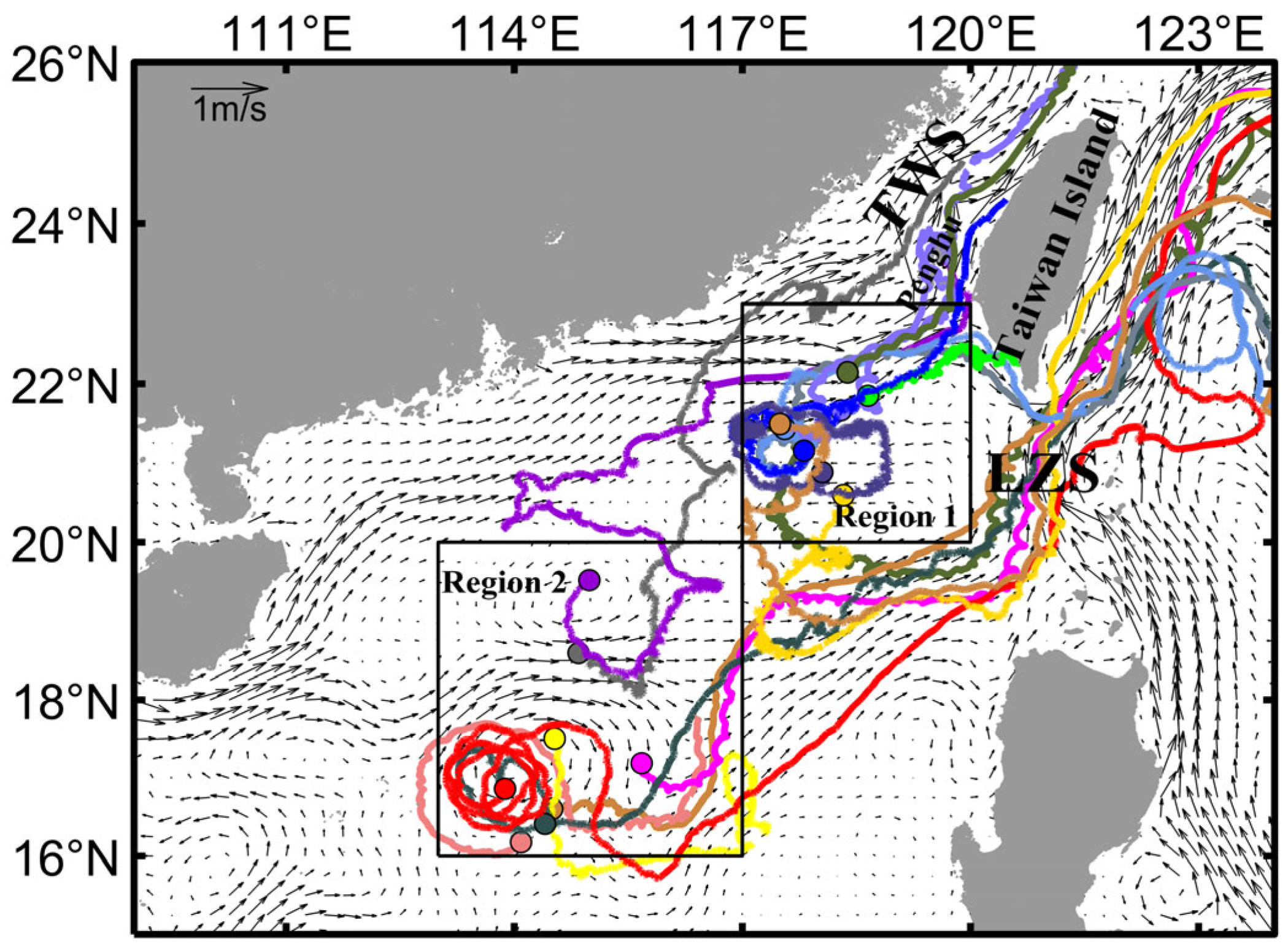




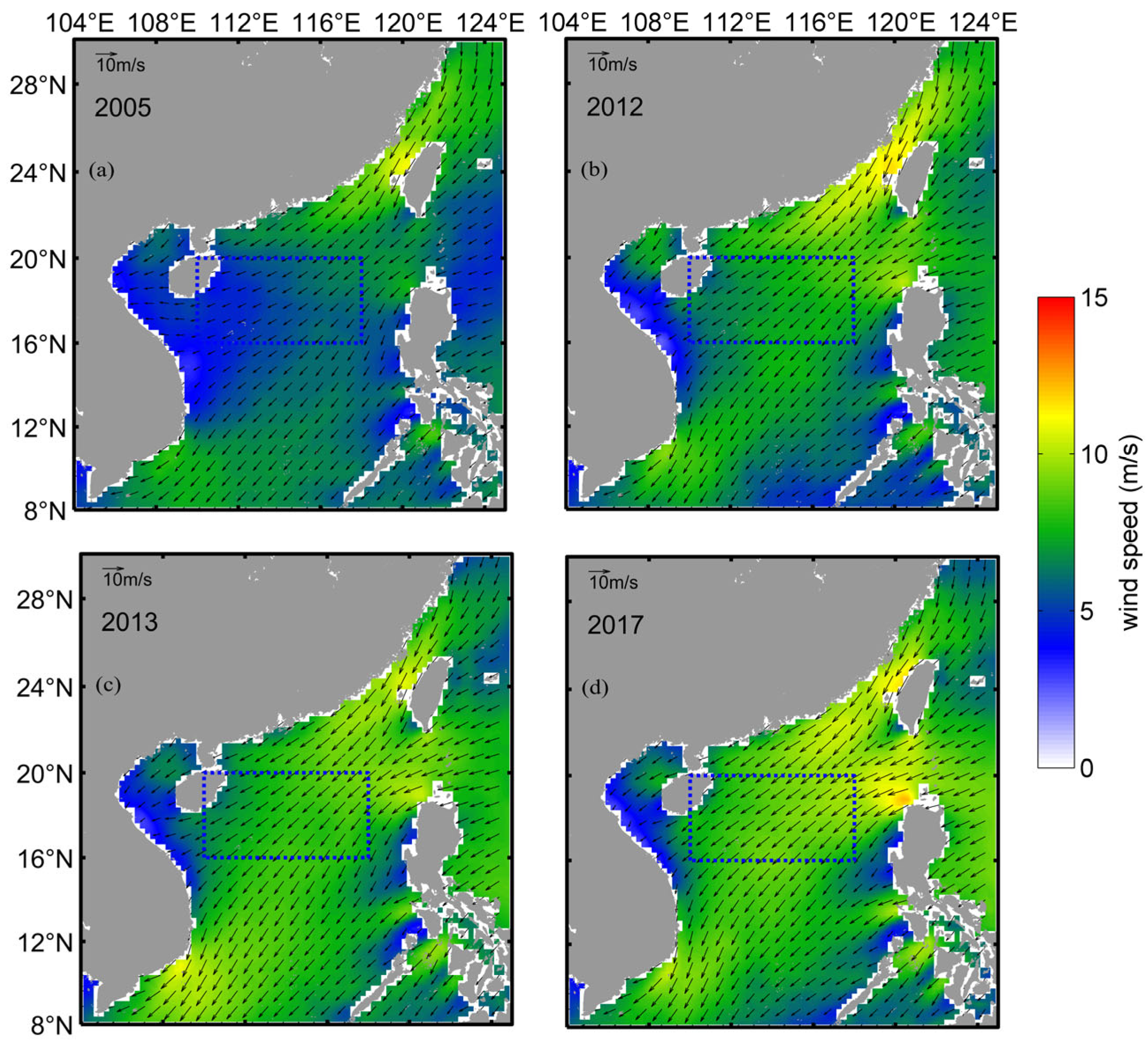

| Period | Eddy Amplitude (m) | AKE (m2/s2) |
|---|---|---|
| 27 March–20 April 2021 | 0.22 [0.198, 0.235] | 0.11 [0.099, 0.115] |
| 20–29 April 2021 | 0.16 [0.161, 0.168] | 0.16 [0.142, 0.177] |
| 27 April–13 May 2021 | 0.15 [0.138, 0.157] | 0.18 [0.166, 0.197] |
| 9 May–3 June 2021 | 0.11 [0.108, 0.122] | 0.10 [0.092, 0.113] |
| 28 May–22 June 2021 | 0.08 [0.075, 0.094] | 0.09 [0.082, 0.107] |
| 18 June–8 July 2021 | 0.07 [0.065, 0.080] | 0.09 [0.063, 0.117] |
Disclaimer/Publisher’s Note: The statements, opinions and data contained in all publications are solely those of the individual author(s) and contributor(s) and not of MDPI and/or the editor(s). MDPI and/or the editor(s) disclaim responsibility for any injury to people or property resulting from any ideas, methods, instructions or products referred to in the content. |
© 2025 by the authors. Licensee MDPI, Basel, Switzerland. This article is an open access article distributed under the terms and conditions of the Creative Commons Attribution (CC BY) license (https://creativecommons.org/licenses/by/4.0/).
Share and Cite
Hu, Z.; Yang, L.; Sun, Z.; Chen, Z.; Zhu, J.; Hu, J. Analyzing the Seasonal Variability in South China Sea Surface Currents with Drifter Observations, Satellite-Derived Data, and Reanalysis Data. Oceans 2025, 6, 58. https://doi.org/10.3390/oceans6030058
Hu Z, Yang L, Sun Z, Chen Z, Zhu J, Hu J. Analyzing the Seasonal Variability in South China Sea Surface Currents with Drifter Observations, Satellite-Derived Data, and Reanalysis Data. Oceans. 2025; 6(3):58. https://doi.org/10.3390/oceans6030058
Chicago/Turabian StyleHu, Zhiyuan, Longqi Yang, Zhenyu Sun, Zhaozhang Chen, Jia Zhu, and Jianyu Hu. 2025. "Analyzing the Seasonal Variability in South China Sea Surface Currents with Drifter Observations, Satellite-Derived Data, and Reanalysis Data" Oceans 6, no. 3: 58. https://doi.org/10.3390/oceans6030058
APA StyleHu, Z., Yang, L., Sun, Z., Chen, Z., Zhu, J., & Hu, J. (2025). Analyzing the Seasonal Variability in South China Sea Surface Currents with Drifter Observations, Satellite-Derived Data, and Reanalysis Data. Oceans, 6(3), 58. https://doi.org/10.3390/oceans6030058






